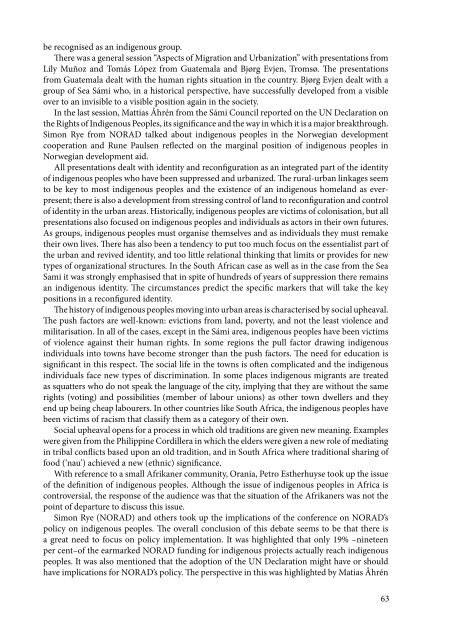Summary of Conference - Munin
Summary of Conference - Munin
Summary of Conference - Munin
Create successful ePaper yourself
Turn your PDF publications into a flip-book with our unique Google optimized e-Paper software.
e recognised as an indigenous group.<br />
There was a general session “Aspects <strong>of</strong> Migration and Urbanization” with presentations from<br />
Lily Muñoz and Tomás López from Guatemala and Bjørg Evjen, Tromsø. The presentations<br />
from Guatemala dealt with the human rights situation in the country. Bjørg Evjen dealt with a<br />
group <strong>of</strong> Sea Sámi who, in a historical perspective, have successfully developed from a visible<br />
over to an invisible to a visible position again in the society.<br />
In the last session, Mattias Åhrén from the Sámi Council reported on the UN Declaration on<br />
the Rights <strong>of</strong> Indigenous Peoples, its significance and the way in which it is a major breakthrough.<br />
Simon Rye from NORAD talked about indigenous peoples in the Norwegian development<br />
cooperation and Rune Paulsen reflected on the marginal position <strong>of</strong> indigenous peoples in<br />
Norwegian development aid.<br />
All presentations dealt with identity and reconfiguration as an integrated part <strong>of</strong> the identity<br />
<strong>of</strong> indigenous peoples who have been suppressed and urbanized. The rural-urban linkages seem<br />
to be key to most indigenous peoples and the existence <strong>of</strong> an indigenous homeland as everpresent;<br />
there is also a development from stressing control <strong>of</strong> land to reconfiguration and control<br />
<strong>of</strong> identity in the urban areas. Historically, indigenous peoples are victims <strong>of</strong> colonisation, but all<br />
presentations also focused on indigenous peoples and individuals as actors in their own futures.<br />
As groups, indigenous peoples must organise themselves and as individuals they must remake<br />
their own lives. There has also been a tendency to put too much focus on the essentialist part <strong>of</strong><br />
the urban and revived identity, and too little relational thinking that limits or provides for new<br />
types <strong>of</strong> organizational structures. In the South African case as well as in the case from the Sea<br />
Sami it was strongly emphasised that in spite <strong>of</strong> hundreds <strong>of</strong> years <strong>of</strong> suppression there remains<br />
an indigenous identity. The circumstances predict the specific markers that will take the key<br />
positions in a reconfigured identity.<br />
The history <strong>of</strong> indigenous peoples moving into urban areas is characterised by social upheaval.<br />
The push factors are well-known: evictions from land, poverty, and not the least violence and<br />
militarisation. In all <strong>of</strong> the cases, except in the Sámi area, indigenous peoples have been victims<br />
<strong>of</strong> violence against their human rights. In some regions the pull factor drawing indigenous<br />
individuals into towns have become stronger than the push factors. The need for education is<br />
significant in this respect. The social life in the towns is <strong>of</strong>ten complicated and the indigenous<br />
individuals face new types <strong>of</strong> discrimination. In some places indigenous migrants are treated<br />
as squatters who do not speak the language <strong>of</strong> the city, implying that they are without the same<br />
rights (voting) and possibilities (member <strong>of</strong> labour unions) as other town dwellers and they<br />
end up being cheap labourers. In other countries like South Africa, the indigenous peoples have<br />
been victims <strong>of</strong> racism that classify them as a category <strong>of</strong> their own.<br />
Social upheaval opens for a process in which old traditions are given new meaning. Examples<br />
were given from the Philippine Cordillera in which the elders were given a new role <strong>of</strong> mediating<br />
in tribal conflicts based upon an old tradition, and in South Africa where traditional sharing <strong>of</strong><br />
food (‘nau’) achieved a new (ethnic) significance.<br />
With reference to a small Afrikaner community, Orania, Petro Estherhuyse took up the issue<br />
<strong>of</strong> the definition <strong>of</strong> indigenous peoples. Although the issue <strong>of</strong> indigenous peoples in Africa is<br />
controversial, the response <strong>of</strong> the audience was that the situation <strong>of</strong> the Afrikaners was not the<br />
point <strong>of</strong> departure to discuss this issue.<br />
Simon Rye (NORAD) and others took up the implications <strong>of</strong> the conference on NORAD’s<br />
policy on indigenous peoples. The overall conclusion <strong>of</strong> this debate seems to be that there is<br />
a great need to focus on policy implementation. It was highlighted that only 19% –nineteen<br />
per cent–<strong>of</strong> the earmarked NORAD funding for indigenous projects actually reach indigenous<br />
peoples. It was also mentioned that the adoption <strong>of</strong> the UN Declaration might have or should<br />
have implications for NORAD’s policy. The perspective in this was highlighted by Matias Åhrén<br />
63
















